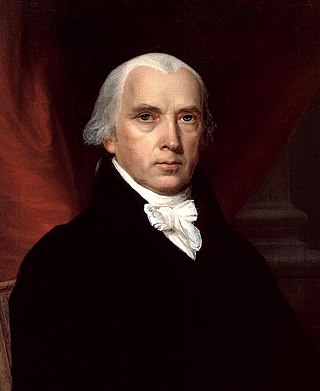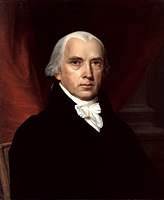
The Republican Party, retroactively called the Democratic-Republican Party, and also referred to as the Jeffersonian Republican Party among other names, was an American political party founded by Thomas Jefferson and James Madison in the early 1790s that championed liberalism, republicanism, individual liberty, equal rights, decentralization, free markets, free trade, agrarianism, and sympathy with the French Revolution. The party became increasingly dominant after the 1800 elections as the opposing Federalist Party collapsed.

The 1792 United States presidential election was the second quadrennial presidential election. It was held from Friday, November 2, to Wednesday, December 5, 1792. Incumbent President George Washington was elected to a second term by a unanimous vote in the electoral college, while John Adams was re-elected as vice president. Washington was essentially unopposed, but Adams faced a competitive re-election against Governor George Clinton of New York.

The 1808 United States presidential election was the sixth quadrennial presidential election, held from Friday, November 4, to Wednesday, December 7, 1808. The Democratic-Republican candidate James Madison defeated Federalist candidate Charles Cotesworth Pinckney decisively.

The 1812 United States presidential election was the seventh quadrennial presidential election. It was held from Friday, October 30, 1812, to Wednesday, December 2, 1812. Taking place in the shadow of the War of 1812, incumbent Democratic-Republican President James Madison defeated DeWitt Clinton, the Lieutenant Governor of New York and Mayor of New York City, who drew support from dissident Democratic-Republicans in the North as well as Federalists. It was the first presidential election to be held during a major war involving the United States.

The 1816 United States presidential election was the eighth quadrennial presidential election. It was held from November 1 to December 4, 1816. In the first election following the end of the War of 1812, Democratic-Republican candidate James Monroe defeated Federalist Rufus King. The election was the last in which the Federalist Party fielded a presidential candidate.

The 1813 United States Senate election in New York was held on February 2, 1813, by the New York State Legislature to elect a U.S. Senator to represent the State of New York in the United States Senate.

The 1812 United States elections elected the members of the 13th United States Congress. The election took place during the First Party System, and shortly after the start of the War of 1812. The Federalist Party made a relatively strong showing, winning seats in both chambers while supporting a competitive challenge to the incumbent Democratic-Republican president. However, the Democratic-Republican Party continued its control of the presidency and both houses of Congress.

The 1812 United States presidential election in Connecticut took place between October 30 and December 2, 1812, as part of the 1812 United States presidential election. The state legislature chose nine representatives, or electors to the Electoral College, who voted for President and Vice President.

The 1812 United States presidential election in New York took place between October 30 and December 2, 1812, as part of the 1812 United States presidential election. The state legislature chose 29 representatives, or electors to the Electoral College, who voted for President and Vice President.

The 1812 United States presidential election in New Jersey took place between October 30 and December 2, 1812, as part of the 1812 United States presidential election. The state legislature chose eight representatives, or electors to the Electoral College, who voted for President and Vice President.

The 1812 United States presidential election in Ohio took place as part of the 1812 United States presidential election. Voters chose 8 representatives, or electors to the Electoral College, who voted for President and Vice President.

The 1812 United States presidential election in Virginia took place between October 30 and December 2, 1812, as part of the 1812 United States presidential election. Voters chose 25 representatives, or electors to the Electoral College, who voted for President and Vice President.

The 1812 United States presidential election in Maryland took place on an unknown date in 1812, as part of the 1812 presidential election. Voters chose eleven representatives, or electors to the Electoral College, who voted for President and Vice President.

The 1812 United States presidential election in Massachusetts took place between November 1 and 3, 1812, as part of the 1812 United States presidential election. Voters chose 22 representatives, or electors to the Electoral College, who voted for President and Vice President.

The 1812 United States presidential election in Tennessee took place between October 30 and December 2, 1812, as part of the 1812 United States presidential election. Voters chose eight representatives, or electors, to the Electoral College, who voted for President and Vice President.


















